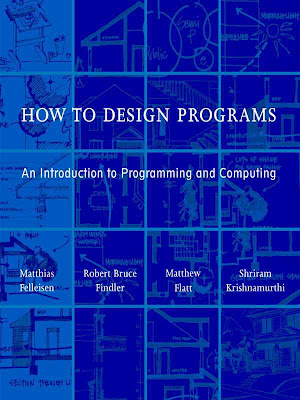
Matthias Felleisen
Robert Bruce Findler
Matthew Flatt
Shriram Krishnamurthi
Contents
Preface
Why Everyone Should Learn to Program
Design Recipes
The Choice of Scheme and DrScheme
The Parts of the Book
Acknowledgments
I Processing Simple Forms of Data
1 Students, Teachers, and Computers
2 Numbers, Expressions, Simple Programs
2.1 Numbers and Arithmetic
2.2 Variables and Programs
2.3 Word Problems
2.4 Errors
2.5 Designing Programs
6 Compound Data, Part 1: Structures
6.1 Structures
6.2 Extended Exercise: Drawing Simple Pictures
6.3 Structure Definitions
6.4 Data Definitions
6.5 Designing Functions for Compound Data
6.6 Extended Exercise: Moving Circles and Rectangles
6.7 Extended Exercise: Hangman
7 The Varieties of Data
7.1 Mixing and Distinguishing Data
7.2 Designing Functions for Mixed Data
7.3 Composing Functions, Revisited
7.4 Extended Exercise: Moving Shapes
7.5 Input Errors
8 Intermezzo 1: Syntax and Semantics
8.2 The Scheme Vocabulary
8.3 The Scheme Grammar
8.4 The Meaning of Scheme
8.5 Errors
8.6 Boolean Expressions
8.7 Variable Definitions
8.8 Structure Definitions
II Processing Arbitrarily Large Data
9 Compound Data, Part 2: Lists
9.1 Lists
9.2 Data Definitions for Lists of Arbitrary Length
9.3 Processing Lists of Arbitrary Length
9.4 Designing Functions for Self-Referential Data Definitions
9.5 More on Processing Simple Lists
10 More on Processing Lists
10.1 Functions that Produce Lists
10.2 Lists that Contain Structures
10.3 Extended Exercise:
13 Intermezzo 2: List Abbreviations
III More on Processing Arbitrarily Large Data
14 More Self-referential Data Definitions
14.1 Structures in Structures
14.2 Extended Exercise: Binary Search Trees
14.3 Lists in Lists
14.4 Extended Exercise: Evaluating Scheme
15 Mutually Referential Data Definitions
15.1 Lists of Structures, Lists in Structures
15.2 Designing Functions for Mutually Referential Definitions
15.3 Extended Exercise: More on Web Pages
16 Development through Iterative Refinement
16.1 Data Analysis
16.2 Defining Data Classes and Refining Them
16.3 Refining Functions and Programs
17 Processing Two Complex Pieces of Data
17.1 Processing Two Lists Simultaneously: Case 1
17.2 Processing Two Lists Simultaneously: Case 2
17.3 Processing Two Lists Simultaneously: Case 3
17.4 Function Simplification
17.5 Designing Functions that Consume Two Complex Inputs
17.6 Exercises on Processing Two Complex Inputs
17.7 Extended Exercise: Evaluating Scheme, Part 2
17.8 Equality and Testing
18 Intermezzo 3: Local Definitions and Lexical Scope
18.2 Organizing Programs with local
Syntax of local
Semantics of local
20 Functions are Values
20.1 Syntax and Semantics
20.2 Contracts for Abstract and Polymorphic Functions
21 Designing Abstractions from Examples
21.1 Abstracting from Examples
21.2 Finger Exercises with Abstract List Functions
21.3 Abstraction and a Single Point of Control
21.4 Extended Exercise: Moving Pictures, Again
21.5 Note: Designing Abstractions from Templates
22 Designing Abstractions with First-Class Functions
22.1 Functions that Produce Functions
22.2 Designing Abstractions with Functions-as-Values
22.3 A First Look at Graphical User Interface
23 Mathematical Examples
23.1 Sequences and Series
23.2 Arithmetic Sequences and Series
23.3 Geometric Sequences and Series
Taylor Series
23.4 The Area Under a Function
23.5 The Slope of a Function
24 Intermezzo 4: Defining Functions on the Fly
Syntax of lambda
Scope and Semantics of lambda
Pragmatics of lambda
V Generative Recursion
25 A New Form of Recursion
25.1 Modeling a Ball on a Table
25.2 Sorting Quickly
26 Designing Algorithms
26.1 Termination
26.2 Structural versus Generative Recursion
26.3 Making Choices
29 Intermezzo 5: The Cost of Computing and Vectors
29.2 Concrete Time, Abstract Time
29.3 The Definition of ``on the Order of''
29.4 A First Look at Vectors
VI Accumulating Knowledge
30 The Loss of Knowledge
30.1 A Problem with Structural Processing
30.2 A Problem with Generative Recursion
31 Designing Accumulator-Style Functions
31.1 Recognizing the Need for an Accumulator
31.2 Accumulator-Style Functions
31.3 Transforming Functions into Acc
32 More Uses of Accumulation
32.1 Extended Exercise: Accumulators on Trees
32.2 Extended Exercise: Missionaries and Cannibals
32.3 Extended Exercise: Board Solitaire
33 Intermezzo 6: The Nature of Inexact Numbers
33.2 Fixed-size Number Arithmetic
33.3 Overflow
33.4 Underflow
33.5 DrScheme's Numbers
VII Changing the State of Variables
34 Memory for Functions
35 Assignment to Variables
35.1 Simple Assignments at Work
35.2 Sequencing Expression Evaluations
35.3 Assignments and Functions
35.4 A First Useful Example
38 Intermezzo 7: The Final Syntax and Semantics
38.2 The Vocabulary of Advanced Scheme
38.3 The Grammar of Advanced Scheme
38.4 The Meaning of Advanced Scheme
38.5 Errors in Advanced Scheme
VIII Changing Compound Values
39 Encapsulation
39.1 Abstracting with State Variables
39.2 Practice with Encapsulation
40 Mutable Structures
40.1 Structures from Functions
40.2 Mutable Functional Structures
40.3 M
Other Algorithm Books
Other Computing Books
Computing - Wikipedia, the free encyclopedia
Computer programming - Wikipedia, the free encyclopedia
Grid Computing
Data Structures and Algorithms with Object-Oriented Design Patterns in Java
Download
No comments:
Post a Comment